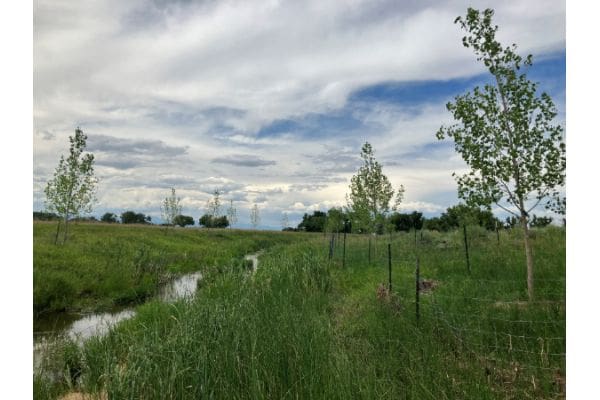First Creek Waterway Project Completes Vital Riparian Restoration

The First Creek Waterway Project, aimed at revitalizing and restoring First Creek, a critical South Platte River tributary within Colorado’s Rocky Mountain Arsenal National Wildlife Refuge, is complete thanks to the dedicated efforts of volunteers and the U.S. Fish and Wildlife Service.
The project was completed through a $10,000 grant provided by the National Wild Turkey Federation under the Waterways for Wildlife Initiative, a comprehensive, landscape-level effort, to address critically urgent conservation needs in riparian ecosystems along rivers and streams in the Great Plains of the United States.
In the arid plains of the west, riparian areas serve as a natural draw for a diverse array of wildlife, including wild turkeys. Unfortunately, many of these crucial wildlife habitats have deteriorated due to a range of factors. To tackle pressing conservation challenges, the NWTF is collaborating with landowners, governmental agencies and other conservation organizations. Together, they are committed to revitalizing these vital ecosystems throughout the region.
First Creek, significant as habitat for wild turkey and various wildlife, a nesting site for bald eagles and a crucial water source for the bison herd, suffers from degradation and channelization, or the straightening and deepening of river/creek channels, leading to a decline in natural vegetation and an increased risk of flooding across 140 acres of riparian habitat.
The First Creek Waterway Project was initiated to address these issues by implementing a multifaceted approach that included the removal of invasive flora, replanting with native species and reshaping creek banks to enhance water quality and mitigate floods. These efforts aimed to restore the creek’s original floodplain and flow patterns, rejuvenating its ecosystem.
“The Rocky Mountain Arsenal serves as a sanctuary for individuals from urban areas, some of whom have limited exposure to nature,” said Chuck Carpenter, NWTF district biologist for Utah, Colorado, New Mexico and Arizona. “The NWTF is honored to collaborate with the Fish and Wildlife Service in our efforts to conserve and improve the vital riparian areas that form the lifeblood of this refuge.”
The project, primarily executed between May and August, reached a successful completion, thanks to the support of community volunteers, the Mile High Youth Corps and the American Conservation Experience. Throughout the course of the project, volunteers planted 26 cottonwood trees and 100 Golden Currant and Buffaloberry bushes along ¾ of a mile of First Creek. Additionally, volunteers installed protective fencing around the cottonwoods and shrubs to shield them from grazing during the initial years.
“People from as young as six up through grandparents’ age enjoyed volunteering,” said Kim Lopez FWS Volunteer Coordinator. “This project was able to bring people together to find family and tradition on the Refuge.”
As part of the ongoing commitment to the project’s success, the FWS will continue to water and maintain the newly planted vegetation to ensure its establishment in the area. Regular mowing and invasive species removal will be integral to sustaining the project’s positive outcomes.
The planting of cottonwood trees and native bushes will create a diverse age system of plants and trees, contributing to a more sustainable solution for the future. Future work will focus on further enhancing the area, including the restoration of steep creek banks and the natural flow of the creek.
“The high number of volunteers from the communities surrounding Rocky Mountain Arsenal National Wildlife Refuge who came out to help restore the riparian habitat along First Creek exceeded our expectations and shows just how much people care about wildlife,” said Teresa Crane, FWS grants management specialist. “The sheer volume of work that was done in this short period of time would not have been possible without the support of the National Wild Turkey Federation.”
Learn more about the Waterways for Wildlife initiative, here.
The post First Creek Waterway Project Completes Vital Riparian Restoration appeared first on HuntingLife.com.
